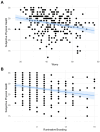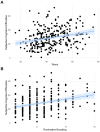Worry and ruminative brooding: associations with cognitive and physical health in older adults
- PMID: 39021658
- PMCID: PMC11252046
- DOI: 10.3389/fpsyg.2024.1332398
Worry and ruminative brooding: associations with cognitive and physical health in older adults
Abstract
Introduction: Mental health conditions are associated with cognition and physical function in older adults. We examined whether worry and ruminative brooding, key symptoms of certain mental health conditions, are related to subjective and/or objective measures of cognitive and physical (cardiovascular) health.
Methods: We used baseline data from 282 participants from the SCD-Well and Age-Well trials (178 female; agemean = 71.1 years). We measured worry and ruminative brooding using the Penn State Worry Questionnaire and the Ruminative Response Scale-brooding subscale. We assessed subjective physical health using the WHOQOL-Bref physical subscale, and objective physical health via blood pressure and modified versions of the Framingham Risk Score and Charlson Comorbidity Index. With subjective and objective cognition, we utilized the Cognitive Difficulties Scale and a global composite (modified Preclinical Alzheimer's Cognitive Composite, PACC5, with the Wechsler Adult Intelligence Scale-IV, category fluency, Mattis Dementia Rating Scale-2, and either the California Verbal Learning Test or the Rey Auditory Verbal Learning Test). We conducted linear regressions, adjusted for education, age, sex and cohort.
Results: Worry and ruminative brooding were negatively associated with subjective physical health (worry: β = -0.245, 95%CI -0.357 to -0.133, p < 0.001; ruminative brooding: β = -0.224, 95%CI -0.334 to -0.113, p < 0.001) and subjective cognitive difficulties (worry: β = 0.196, 95%CI 0.091 to 0.302, p < 0.001; ruminative brooding: β = 0.239, 95%CI 0.133 to 0.346, p < 0.001). We did not observe associations between worry or ruminative brooding and any measure of objective health.
Discussion: Worry and ruminative brooding may be common mechanisms associated with subjective but not objective health. Alternatively, cognitively unimpaired older adults may become aware of subtle changes not captured by objective measures used in this study. Interventions reducing worry and ruminative brooding may promote subjective physical and cognitive health; however, more research is needed to determine causality of the relationships.
Keywords: cognition; perseverative cognition; physical health; repetitive negative thinking; rumination; worry.
Copyright © 2024 Morse, Koutsoubelis, Whitfield, Demnitz-King, Ourry, Stott, Chocat, Devouge, Walker, Klimecki, Collette, Chetelat, Gonneaud, Poisnel and Marchant for the Medit-Ageing Research Group.
Conflict of interest statement
The authors declare that the research was conducted in the absence of any commercial or financial relationships that could be construed as a potential conflict of interest.
Figures


References
-
- Armey M. F., Fresco D. M., Moore M. T., Mennin D. S., Turk C. L., Heimberg R. G., et al. . (2009). Brooding and pondering: isolating the active ingredients of depressive rumination with exploratory factor analysis and structural equation modeling. Assessment 16, 315–327. doi: 10.1177/1073191109340388, PMID: - DOI - PMC - PubMed
-
- Assessing Cardiovascular Risk: Systematic Evidence Review from the Risk Assessment Work Group . (2013). National Heart, Lung, and Blood Institute. Available at: https://www.nhlbi.nih.gov/sites/default/files/media/docs/risk-assessment....
-
- Bamia C., Orfanos P., Juerges H., Schöttker B., Brenner H., Lorbeer R., et al. . (2017). Self-rated health and all-cause and cause-specific mortality of older adults: individual data meta-analysis of prospective cohort studies in the CHANCES consortium. Maturitas 103, 37–44. doi: 10.1016/j.maturitas.2017.06.023 - DOI - PubMed
-
- Barnes L. L. B., Harp D., Jung W. S. (2002). Reliability generalization of scores on the Spielberger state-trait anxiety inventory. Educ. Psychol. Meas. 62, 603–618. doi: 10.1177/0013164402062004005 - DOI
LinkOut - more resources
Full Text Sources

